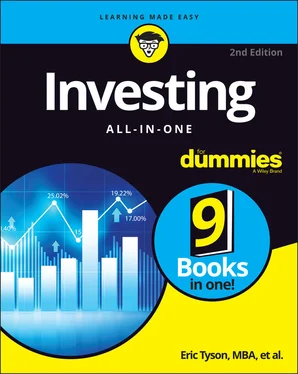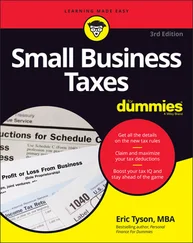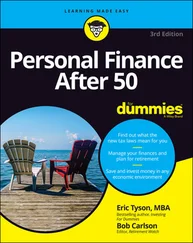Eric Tyson - Investing All-in-One For Dummies
Здесь есть возможность читать онлайн «Eric Tyson - Investing All-in-One For Dummies» — ознакомительный отрывок электронной книги совершенно бесплатно, а после прочтения отрывка купить полную версию. В некоторых случаях можно слушать аудио, скачать через торрент в формате fb2 и присутствует краткое содержание. Жанр: unrecognised, на английском языке. Описание произведения, (предисловие) а так же отзывы посетителей доступны на портале библиотеки ЛибКат.
- Название:Investing All-in-One For Dummies
- Автор:
- Жанр:
- Год:неизвестен
- ISBN:нет данных
- Рейтинг книги:3 / 5. Голосов: 1
-
Избранное:Добавить в избранное
- Отзывы:
-
Ваша оценка:
- 60
- 1
- 2
- 3
- 4
- 5
Investing All-in-One For Dummies: краткое содержание, описание и аннотация
Предлагаем к чтению аннотацию, описание, краткое содержание или предисловие (зависит от того, что написал сам автор книги «Investing All-in-One For Dummies»). Если вы не нашли необходимую информацию о книге — напишите в комментариях, мы постараемся отыскать её.
Investing All-in-One For Dummies
.
Dummies
Investing All-in-One For Dummies
Investing All-in-One For Dummies
Investing All-in-One For Dummies — читать онлайн ознакомительный отрывок
Ниже представлен текст книги, разбитый по страницам. Система сохранения места последней прочитанной страницы, позволяет с удобством читать онлайн бесплатно книгу «Investing All-in-One For Dummies», без необходимости каждый раз заново искать на чём Вы остановились. Поставьте закладку, и сможете в любой момент перейти на страницу, на которой закончили чтение.
Интервал:
Закладка:
More often than not, these critics, who typically and erroneously claim to have predicted the 2008 crisis, have an agenda to appear smarter than everyone else, including the Fed. Some of these pseudo-experts are precious metals hucksters and thus like to claim that the Fed is going to cause hyperinflation that will impoverish you unless you buy gold, silver, and the like.
In one popular video from 2010 that has millions of views on YouTube, the author claims the following using goofy cartoonish characters:
The Fed is printing a ton of money to implement quantitative easing (QE).
QE is being done to stop deflation (falling prices), but the Fed is too dumb to realize that consumer prices are rising, not falling.
The Fed has been wrong about everything the past 20 years.
Then Fed Chairman Ben Bernanke is unqualified for his job because he has no business experience, has no policy experience, and has never held an elected office. He is a fool who’s been wrong about everything during his tenure in office and has already blown up the American economy and is now working on blowing up the world economy.
The government is stupidly buying Treasuries from Goldman Sachs at grossly inflated prices (rather than buying Treasuries from the Treasury department). Goldman Sachs is ripping off the American people.
Although it’s stunning in and of itself that this video has been watched millions of times, even more amazing and disturbing is how many mainstream media and other websites and outlets have promoted and recommended the video, making little if any effort to fact-check and reality-check its contents. Here we set the record straight and advance your understanding of what quantitative easing really is and why the Fed is doing it. We go through the video’s main assertions point by point:
The Fed is not printing a ton of money (expanding the money supply) to implement QE. Retail money market assets and bank deposits could increase, for example, if individuals decided to hold more cash. Demand for these highly liquid assets can come from folks around the world, so increased demand for the U.S. dollar during times of stress can lead to the growth of M2 (the leading measure of the money supply). Changes in money supply are complicated.
The Fed is well aware that there’s inflation right now but has been concerned that the rate has been quite low by historical standards and that there were signs of accelerating deflation during the severe recession.
If the Fed had been wrong about everything the past 20-plus years, our economy would be in shambles and our stock market wouldn’t have appreciated more than 1,400 percent since 1990. Before the COVID-19 pandemic and government-mandated shutdowns, the U.S. unemployment rate was at a 50-year low at 3.5 percent.
Bernanke was well qualified for his job.
The Fed is buying Treasuries from banks at competitive prices and is doing so to encourage more bank lending. Saying that the Fed is directing this buying solely to Goldman Sachs is absurd. The Fed conducts such Treasury open market operations through an approved list of 18 primary dealers, and Goldman is one of the 18 dealers operating in a highly competitive environment. Goldman bashing has been going on for a long time.
Interestingly, there hasn’t been much questioning of the background and agenda of the person behind this fact-challenged YouTube video, who in some articles is referred to as a “30-year-old real estate manager.” He has no discernible background or expertise in the subject matter discussed in the video, which helps explain why nearly every statement in the video is wrong.
In various speeches and selected interviews, former Fed Chairman Bernanke has explained QE. Here’s one fairly plain English explanation that Bernanke gave during the height of the credit crisis ( Note: “Central bank” means the Federal Reserve):
Quantitative easing can be thought of as an expansion of the central bank’s balance sheet with no intentional change in its composition. That is, the central bank undertakes more open market operations with the objective of expanding bank reserve balances, which the banking system should then use to make new loans and buy additional securities. However, when credit spreads are very wide, as they are at present, and the credit markets are quite dysfunctional, it becomes less likely that new loans and additional securities purchases will result from increasing bank reserve balances.
In contrast, credit easing focuses on the mix of loans and securities that the central bank holds as assets on its balance sheet as a means to reduce credit spreads and improve the functioning of private credit markets. The ultimate objective is improvement in the credit conditions faced by households and businesses. In this respect, the Federal Reserve has focused on improving functioning in the credit markets that are severely disrupted and that are key sources of funding for financial firms, nonfinancial firms, and households.
Book 2
Investing in Your 20s and 30s
Contents at a Glance
1 Chapter 1: Using Investments to Accomplish Your Goals Setting and Prioritizing Your Shorter-Term Goals Investing in Retirement Accounts
2 Chapter 2: Minimizing Your Taxes When Investing Understanding Investment Taxes Reducing Your Taxes When Selling Investments
3 Chapter 3: Laying Out Your Financial Plans First Priorities: Paying Off High-Cost Debt and Building a Safety Reserve What about Paying Down Other Debts? Sorting Out Your Financial Plans Knowing the Impact of Investing for College Costs Securing Proper Insurance
4 Chapter 4: Starting Out with Bank and Credit Union Accounts Understanding FDIC Bank Insurance Investing in Banking Account and Savings Vehicles Negotiating with Bankers Feeling Secure with Your Bank Exploring Alternatives to Bank Accounts
Chapter 1
Using Investments to Accomplish Your Goals
IN THIS CHAPTER
 Investing for short-term consumption goals
Investing for short-term consumption goals
 Planning for financial independence or retirement
Planning for financial independence or retirement
Saving and investing money can make you feel good and in control. Ultimately, most folks are investing money to accomplish particular goals. Saving and investing for a car purchase, expenses for higher education, a home purchase, new furniture, or a vacation are typical short-term goals. You can also invest toward longer-term goals, such as your financial independence or retirement decades in the future.
This chapter discusses how you can use investments to accomplish common shorter- and longer-term goals.
Setting and Prioritizing Your Shorter-Term Goals
Unless you earn really big bucks or expect to have a large family inheritance to tap, your personal and financial desires will probably outstrip your resources. Thus, you must prioritize your goals.
One of the biggest mistakes people make is rushing into a financial decision without considering what’s really important to them. Because many people get caught up in the responsibilities of their daily lives, they don’t take time for reflection often because they feel that they lack the time. Take that time, because people who identify their goals and then work toward them, which often requires changing some habits, are far more likely to accomplish something significant.
This section discusses common “shorter-term” financial goals — such as establishing an emergency reserve, making major purchases, owning a home, and starting a small business — and how to work toward them. Accomplishing such goals almost always requires saving money.
Читать дальшеИнтервал:
Закладка:
Похожие книги на «Investing All-in-One For Dummies»
Представляем Вашему вниманию похожие книги на «Investing All-in-One For Dummies» списком для выбора. Мы отобрали схожую по названию и смыслу литературу в надежде предоставить читателям больше вариантов отыскать новые, интересные, ещё непрочитанные произведения.
Обсуждение, отзывы о книге «Investing All-in-One For Dummies» и просто собственные мнения читателей. Оставьте ваши комментарии, напишите, что Вы думаете о произведении, его смысле или главных героях. Укажите что конкретно понравилось, а что нет, и почему Вы так считаете.












